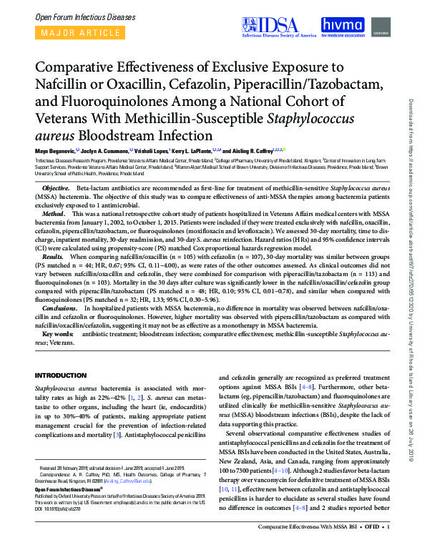
Objective: Beta-lactam antibiotics are recommended as first-line for treatment of methicillin-sensitive Staphylococcus aureus (MSSA) bacteremia. The objective of this study was to compare effectiveness of anti-MSSA therapies among bacteremia patients exclusively exposed to 1 antimicrobial.
Method: This was a national retrospective cohort study of patients hospitalized in Veterans Affairs medical centers with MSSA bacteremia from January 1, 2002, to October 1, 2015. Patients were included if they were treated exclusively with nafcillin, oxacillin, cefazolin, piperacillin/tazobactam, or fluoroquinolones (moxifloxacin and levofloxacin). We assessed 30-day mortality, time to discharge, inpatient mortality, 30-day readmission, and 30-day S. aureus reinfection. Hazard ratios (HRs) and 95% confidence intervals (CI) were calculated using propensity-score (PS) matched Cox proportional hazards regression model.
Results: When comparing nafcillin/oxacillin (n = 105) with cefazolin (n = 107), 30-day mortality was similar between groups (PS matched n = 44; HR, 0.67; 95% CI, 0.11–4.00), as were rates of the other outcomes assessed. As clinical outcomes did not vary between nafcillin/oxacillin and cefazolin, they were combined for comparison with piperacillin/tazobactam (n = 113) and fluoroquinolones (n = 103). Mortality in the 30 days after culture was significantly lower in the nafcillin/oxacillin/cefazolin group compared with piperacillin/tazobactam (PS matched n = 48; HR, 0.10; 95% CI, 0.01–0.78), and similar when compared with fluoroquinolones (PS matched n = 32; HR, 1.33; 95% CI, 0.30–5.96).
Conclusions: In hospitalized patients with MSSA bacteremia, no difference in mortality was observed between nafcillin/oxacillin and cefazolin or fluoroquinolones. However, higher mortality was observed with piperacillin/tazobactam as compared with nafcillin/oxacillin/cefazolin, suggesting it may not be as effective as a monotherapy in MSSA bacteremia.
Beganovic, M., Cusumano, J. A., Lopes, V., LaPlante, K. L., & Caffrey, A. R. (2019). Comparative Effectiveness of Exclusive Exposure to Nafcillin or Oxacillin, Cefazolin, Piperacillin/Tazobactam, and Fluoroquinolones Among a National Cohort of Veterans With Methicillin-Susceptible Staphylococcus aureus Bloodstream Infection. Open Forum Infectious Diseases, 6(7), ofz270. doi: 10.1093/ofid/ofz270
Available at: https://doi.org/10.1093/ofid/ofz270
